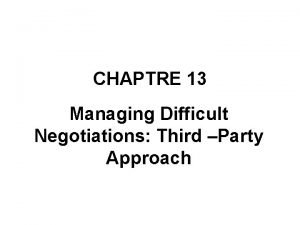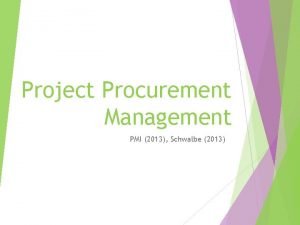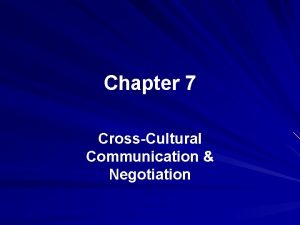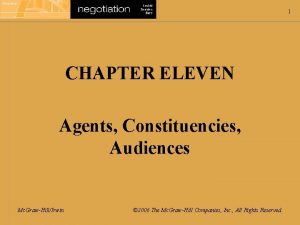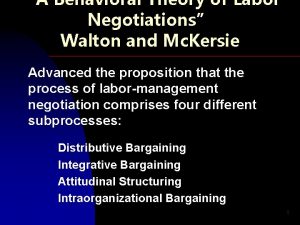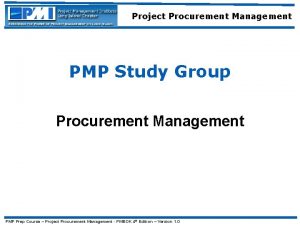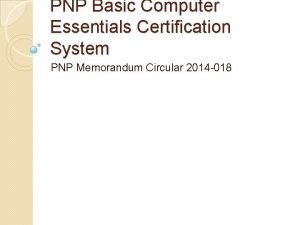Welcome to the CLUIN Internet Seminar Negotiations Training



















































- Slides: 51

Welcome to the CLU-IN Internet Seminar Negotiations Training for OSCs (Module 1) Sponsored by: EPA Office of Superfund Remediation and Technology Innovation Delivered: September 15, 2010, 1: 00 PM - 3: 00 PM, EDT (17: 00 -19: 00 GMT) September 17, 2010, 1: 00 PM - 3: 00 PM, EDT (17: 00 -19: 00 GMT) Instructors: Margaret Ross, EPA Conflict Prevention and Resolution Center, 202. 564. 3221 or ross. margaret@epa. gov Deborah Dalton, EPA Conflict Prevention and Resolution Center, 202. 564. 2913 or dalton. deborah@epa. gov Terry Brubaker, Terry Brubaker & Associates, LLC, 415. 497. 1347 or brubaker. terry@verizon. net Moderator: Jean Balent, EPA, Technology Innovation and Field Services Division, 703. 603. 9924 or balent. jean@epa. gov Visit the Clean Up Information Network online at www. cluin. org

Housekeeping • Please mute your phone lines, Do NOT put this call on hold – press *6 to mute #6 to unmute your lines at anytime • Q&A • Turn off any pop-up blockers • Move through slides using # links on left or buttons Download slides as PPT or PDF Go to slide 1 Move back 1 slide Move forward 1 slide Go to last slide Go to seminar homepage Submit comment or question Report technical problems • This event is being recorded • Archives accessed for free http: //cluin. org/live/archive/ 2

OSC Negotiations Course Module 1: Overview and Process Delivered By: Margaret Ross, EPA CPRC Deborah Dalton, EPA CPRC Terry Brubaker, Consultant 3

Course Credit and Course Evaluation • Please sign in • Your certificate is predicated on attending live deliveries of all 4 modules of the course (total of 8 hours). • After each module, please complete the Clu-In evaluation form. • Attendance for this module will be validated through a roll call, and completion of the evaluation form. • We really value and use these evaluations. We want to provide the best, most relevant trainings, and your feedback is key. 4

Negotiations Course Learning Objectives • At the end of this four module course, you will be able to: – Recognize opportunities to apply interest-based negotiation skills to everyday interactions and relationships – Explain 3 basic components of interest-based negotiation and describe how to apply each concept during the course of a negotiation. – Identify 3 basic communication skills that can help in any negotiation and apply each in common negotiation scenarios. – Explain 4 types of “people” problems, and match each with appropriate strategies to overcome those problems in a negotiation. – Identify when it’s appropriate to involve a facilitator or mediator Note Please feel free to ask questions or contribute your expertise at any time! 5

Negotiations Course Outline • Module 1: Introduction to Interest-Based Negotiation • Module 2: Skills to Improve Communication • Module 3: Skills for Overcoming Obstacles • Module 4: More Skills + “Ask an Expert” 6

Module 1: Introduction to Interest-Based Negotiation 1. 1 What is Negotiation? (definition) • When should I use negotiation? 1. 2 What are the phases of negotiation? • • • Preparation Negotiation Implementation 1. 1 Definitio n 1. 2 Phases 1. 3 Styles 1. 4 Components 1. 3 What are negotiation styles? • • • Soft Bargaining Hard Bargaining Interest-Based Negotiation 1. 4 What are the key components of IBN? • • • Negotiating based on interests Generating multiple options Evaluating based options on objective criteria 7

1. 1 Definitio n 1. 2 Phases 1. 3 Styles 1. 4 Components What is negotiation? “To confer with others in order to come to terms or reach an agreement” Negotiation is a strategy. It is a method for achieving a desired goal. 8

Section 1. 2: What are the phases of a negotiation? 1. 1 Definition 1. 2 Phases 1. 3 Styles 1. 4 Components 9

1. 1 Definitio n 1. 2 Phases 1. 3 Styles 1. 4 Components What are the phases of a negotiation? A typical negotiation will have three major phases: Preparation Negotiation Implementation We will discuss: a) Why you should care about each phase b) What kinds of things you might do in each phase 10

1. 1 Definitio n 1. 2 Phases 1. 3 Styles 1. 4 Components Preparation Negotiation Implementation 11

1. 1 Definitio n 1. 2 Phases 1. 3 Styles 1. 4 Components Phase 1: Preparations (cont. ) Why should I care about preparation? • • You’re at a distinct advantage when you’ve prepared and the other side hasn’t. You can avoid being at a disadvantage when the other side HAS prepared or has preexisting expertise. Anticipating the needs of others during preparation can cut down on negotiation time. Preparing provides good return on investment. Even a few minutes can go a long way. Preparation Negotiation Implementation 12

1. 1 Definitio n 1. 2 Phases 1. 3 Styles 1. 4 Components Phase 1: Preparations (cont. ) What might I do in the preparation phase? • During preparations, you might: – – – – Identify the players involved Consider the problem you’re facing Consider what you want and how bad you want it Consider how others see the problem Consider what they want and how bad they want it Consider what strategies they might pursue Make a go/no-go decision about whether to pursue negotiation as a strategy – Develop a plan for moving forward Preparation Negotiation Implementation 13

1. 1 Definitio n 1. 2 Phases 1. 3 Styles 1. 4 Components Phase 1: Preparations (cont. ) How do I know whether negotiation is my best strategy? “You’ve gotta know when to hold ‘em, know when to fold ‘em, know when to walk away, and know when to run. ” Ask yourself: – – – What can I do to achieve my goals on my own, without them? What can I do to them, to pressure them to meet my goals? How could a third party help further my interests? What are the pros and cons of using an alternative strategy? How would the other side answer these questions? Negotiation may not always be the right strategy, but consider your alternatives carefully. Preparation Negotiation Implementation 14

1. 1 Definitio n 1. 2 Phases 1. 3 Styles 1. 4 Components Negotiation Preparation Negotiation Implementation 15

1. 1 Definitio n 1. 2 Phases 1. 3 Styles 1. 4 Components Phase 2: Negotiation Why should I care about negotiation? • Negotiation may be the best strategy, and is occasionally the only strategy, for getting what you want. • Negotiations are an opportunity to build or improve relationships with people you’ll work with again in the future. • A group of negotiators working together can come up with options and possible solutions that they couldn’t have found separately. Preparation Negotiation Implementation 16

1. 1 Definitio n 1. 2 Phases 1. 3 Styles 1. 4 Components Phase 2: Negotiation (cont. ) What kinds of things do you do in the negotiation phase? • During negotiations, you might: – – – – Share how you see the situation Learn how others see the situation Communicate what you’re seeking Ask about what the other party is seeking Discuss potential solutions Figure out how to choose the best solution Make a go/no-go decision about a proposed solution (agreement) – Develop a plan for moving forward Preparation Negotiation Implementation 17

1. 1 Definitio n 1. 2 Phases 1. 3 Styles 1. 4 Components Implementation Preparation Negotiation Implementation 18

1. 1 Definitio n 1. 2 Phases 1. 3 Styles 1. 4 Components Phase 3: Implementation Why should I care about implementation? • A negotiated agreement is only a promise to do something. You can only get what you want if you implement the agreement. • Thinking about implementation up front will help you build in safeguards, check-ins, and consequences for not fulfilling commitments. • Implementation can be complex, and require further negotiations as new issues arise. • Implementation is an opportunity to continue building relationships. Preparation Negotiation Implementation 19

1. 1 Definitio n 1. 2 Phases 1. 3 Styles 1. 4 Components Phase 3: Implementation (cont. ) What kinds of things do you do in the implementation phase? During implementation you might: – Fulfill your obligations under a negotiated agreement. – Validate that the other side has fulfilled its obligations under the negotiated agreement. – Examine whether the negotiated agreement has fully resolved the problem, or whethere are further issues to discuss. Preparation Negotiation Implementation 20

Section 1. 3: What are the styles of negotiation? 1. 1 Definition 1. 2 Phases 1. 3 Styles 1. 4 Components 21

1. 1 Definitio n 1. 2 Phases 1. 3 Styles 1. 4 Components What are negotiation styles? There is more than one way to “confer with others”. Today we will talk about three types of negotiation styles. Soft Bargaining Hard Bargaining Interest-Based Negotiation We will discuss: a) What each style is b) Why your negotiating style matters 22

1. 1 Definitio n 1. 2 Phases 1. 3 Styles 1. 4 Components What are negotiation styles? Hard Bargaining Interest-Based Negotiation AKA: – Accommodation – Conflict Avoidance AKA: – Positional Bargaining – Traditional Negotiation AKA: – Principled Negotiation – Mutual Gains Bargaining Is a: way to avoid personal conflicts Is a: contest of wills Soft Bargaining In which: – The relationship is preserved temporarily, but exploitation of one party continues. – Implementation may fall to a single party. In which: – Persistence and endurance win – Power wins – The terms of implementation may not be considered fair, and redress may be sought. Is an: opportunity to get what you need. In which: – All parties’ interests can be met. – Parties agree to terms of implementation and verification. 23

1. 1 Definitio n 1. 2 Phases 1. 3 Styles 1. 4 Components Why does negotiation style matter? Because it can impact your results. Recent studies have shown that: • Framing goals in terms of underlying goals allows for greater strategic flexibility and produces a greater likelihood of agreement. • Sharing information about underlying goals with negotiating partners increases the number of possible acceptable solutions. • Negotiators who reveal their underlying goals improve the likelihood that they will reach their goals. Our underlying goals are the “interests” that form the foundation of “interest-based negotiation”. 24

1. 1 Definitio n 1. 2 Phases 1. 3 Styles 1. 4 Components Why does negotiation style matter? (cont. ) Because it can impact relationships with your negotiating partners. • • Soft bargaining can lead to resentment that can cause the relationship to break down in the long term. A “hard” bargaining style can rely on coercion, bluffing, and secrecy which can create resentment and power imbalances that corrode relationships in the long term. Even when compromise is achieved in positional bargaining, if all interests are not fully met, the same underlying issues will come up again and again. Interest-based negotiations focus on sharing information, improving communication, meeting the needs of all parties, and building long term working relationships. Even if you don’t have to work with the same person again, your organization may have to work with theirs in the future. 25

Section 1. 4: What are the components of an interest based negotiation? 1. 1 Definition 1. 2 Phases 1. 3 Styles 1. 4 Components 26

1. 1 Definitio n 1. 2 Phases 1. 3 Styles 1. 4 Components What are the key components of IBN? • • • Negotiating based on interests Generating multiple options Using objective criteria to evaluate options Interests Options Objective Criteria We will discuss a) what each component is, b) why you should care about it, and c) how to use it in a negotiation. 27

1. 1 Definitio n 1. 2 Phases 1. 3 Styles 1. 4 Components Identifying Interests Options Objective Criteria 28

1. 1 Definitio n 1. 2 Phases 1. 3 Styles 1. 4 Components Negotiating based on interests What is an interest? Interests describe the needs, desires, and fears that cause people to want what they want, to do what they do, or say what they say. The ability to identify interests is the most important aspect of INTEREST-based negotiation. Note Our interests are WHY we do what we do. When in doubt, ask why. Interests Options Objective Criteria 29

1. 1 Definitio n 1. 2 Phases 1. 3 Styles 1. 4 Components Negotiating based on interests (cont. ) What is an interest? It’s not a position. Positions • Positions are the conclusions we reach about what we want or what we think should happen. • In traditional negotiations, positions tend to be the primary vehicle of communication between negotiators. • Positions can be communicated as demands, offers, assertions, or wants, but always reflect the solution we want to see, not the problem we want to solve. • Negotiators use posturing and/or bluffing to move away from their initial positions until agreement is reached or negotiation is abandoned. Interests Options Objective Criteria 30

1. 1 Definitio n 1. 2 Phases 1. 3 Styles 1. 4 Components Negotiating based on interests (cont. ) Why should I care about interests? • Sharing interests can build trust, enhance relationships & create joint learning. – • Interests can be satisfied in different ways. – • Each side can acknowledge the legitimacy of the other side’s interests without agreeing to any proposed solution. Generating options to meet interests creates more room for negotiation, and allows more creative solutions. If all interests are identified and met, the likelihood of durable agreement increases. – Improved trust and relationships allows for better ability to overcome tough problems. – Opponents are less likely to seek redress if all interests are met. Interests Options Objective Criteria 31

1. 1 Definitio n 1. 2 Phases 1. 3 Styles 1. 4 Components Negotiating based on interests (cont. ) How do I use interests in a negotiation? Before you negotiate: • Identify your own interests – Keep asking why do I need this… • Imagine the other parties’ interests – Keep an open mind, and imagine many variables • Separate needs from aspirations • Involve your team During negotiations: • Note new information and interests • Be open to learning. Ask Why? How? • Generate options that address all interests • Develop evaluation standards that are based on interests. Interests Options Objective Criteria 32

1. 1 Definitio n 1. 2 Phases 1. 3 Styles 1. 4 Components Negotiating based on interests (cont. ) Role Play: • Imagine you’re negotiating a soil sampling plan with a property owner, who is also the PRP. The PRP is taking responsibility, and there is general agreement, but now you’re discussing the details, and the PRP is leery of EPA’s plan. • Scenario A: As you’re negotiating, the PRP says: "You know perfectly well that sampling in that area's a COMPLETE WASTE of money but YOU DON’T CARE 'cause it's not your money!!!" To Do What’s next? Take 2 minutes to write down your thoughts about possible reactions, responses, and next steps. Interests Options Objective Criteria 33

1. 1 Definitio n 1. 2 Phases 1. 3 Styles 1. 4 Components Negotiating based on interests (cont. ) Role Play: (cont. ) • Scenario B: What if the property owner said something like this instead? “I don’t understand the cost-benefit ratio here. It seems like this is a lot of cost but I don’t see what we get in return. How do I know it’s really worth it? ” or “I want you to know that section of land is virgin forest. It has never been built on or dumped in. I can show you. ” To Do What’s next? Take 2 minutes to write down your thoughts about possible reactions, responses, and next steps. Interests Options Objective Criteria 34

1. 1 Definitio n 1. 2 Phases 1. 3 Styles 1. 4 Components Negotiating based on interests (cont. ) Role Play: (cont. ) • Discussion: – – – How did your understanding of the PRP’s interests (fears, desires, or underlying goals) change? Did your next steps/responses change between scenario A and scenario B? Why? Interests Options Objective Criteria 35

1. 1 Definitio n 1. 2 Phases 1. 3 Styles 1. 4 Components Generating Multiple Options Interests Options Objective Criteria 36

1. 1 Definitio n 1. 2 Phases 1. 3 Styles 1. 4 Components Generating multiple options What are options? • Options are possible ways of addressing people’s interests. • Options can address the concerns, fears, desires of any party. • Options can address one interest at a time or multiple interests at once. • Options can be packaged together to begin to form possible proposals for agreement. Interests Options Objective Criteria 37

1. 1 Definitio n 1. 2 Phases 1. 3 Styles 1. 4 Components Generating multiple options (cont. ) Why should I care about generating multiple options? Generating multiple options to address each interest: • Means more flexibility and more likelihood of agreement. The more the better. • Allows you to show good faith by address other’s interests as well as your own. • Provides an opportunity to build relationships by facing problems together with your negotiating partners. • Makes a silver bullet unnecessary: different options might solve different parts of the problem. • Might provide a better “cure”: like chemotherapy, multiple solutions applied at once might improve outcomes. Interests Options Objective Criteria 38

1. 1 Definitio n 1. 2 Phases 1. 3 Styles 1. 4 Components Generating multiple options (cont. ) How do I generate multiple options in a negotiation? Before you negotiate: – Identify your interests and underlying goals. – Brainstorm options by yourself or with your team – Seek multiple options for meeting each interest – Search for options that provide mutual gains, meet multiple interests – Ask others for ideas: stakeholders, technical experts (more than one), etc. During negotiations: – Follow the same steps that you did in preparation with the other parties. For example: • Re-define the problem you’re trying to solve in conjunction with the other parties. – Integrate new information you learn through conversation about interests into you’re the work you did during preparation. Interests Options Objective Criteria 39

1. 1 Definitio n 1. 2 Phases 1. 3 Styles 1. 4 Components Generating multiple options (cont. ) How do I generate options in a negotiation? Suggestions for encouraging creativity: • Change your view: meet someplace new. • Start the session with lots of time for individual brainstorming. • Suspend judgement • Let people have fun. Welcome wild impracticality! • Question perceptions and traditions • Take apart the problem – solve the parts to solve the whole • Change your point of view – how might others see the problem? Interests Options Objective Criteria 40

1. 1 Definitio n 1. 2 Phases 1. 3 Styles 1. 4 Components Generating multiple options (cont. ) Role Play Remember the PRP who was leery of the EPA sampling plan? “I want you to know that section of land is virgin forest. It has never been built on or dumped in. I can show you. ” To Do What’s next? Take 2 minutes to write down your thoughts about possible options that will address the PRPs interests or underlying goals as you understand them. Interests Options Objective Criteria 41

1. 1 Definitio n 1. 2 Phases 1. 3 Styles 1. 4 Components Using Objective Criteria to Evaluate Options Interests Options Objective Criteria 42

1. 1 Definitio n 1. 2 Phases 1. 3 Styles 1. 4 Components Using objective criteria to evaluate options What are objective criteria? • • To Do Objective criteria are the standards by which options and possible solutions can be judged. Criteria must be acceptable to all and applied equally to all options, regardless of who proposed them. All parties owns the criteria upon which decisions will be based. Criteria can be procedural as well as data-based. What are some common criteria or standards you use to evaluate options? Take 30 seconds to write down some thoughts. Interests Options Objective Criteria 43

1. 1 Definitio n 1. 2 Phases 1. 3 Styles 1. 4 Components Using objective criteria to evaluate options (cont. ) Why should I care about objective criteria? Developing and using objective criteria for evaluation: – Addresses perceptions of bias in selected solutions. No one “owns” the solution. – Can help avoid or disarm “dueling scientists. ” – Can even out power or resource imbalances between parties. Note Perceptions of bias are real issues that must be addressed in order for agreement to be reached. Interests Options Objective Criteria 44

1. 1 Definitio n 1. 2 Phases 1. 3 Styles 1. 4 Components Using objective criteria to evaluate options (cont. ) How do I use objective criteria in a negotiation? Before you negotiate: – Find third party or commonly accepted standards of fairness, scientific merit, or precedent. – Include many possible sources of acceptable standards. – Invite new data from all sides. – Share your data and receive feedback. During negotiations: – Frame each problem as a joint search for objective criteria. – Seek information together, based on your interests. – Reason and be open to reason. – Develop criteria jointly, or with the help of mutually agreedupon technical experts. Interests Options Objective Criteria 45

1. 1 Definitio n 1. 2 Phases 1. 3 Styles 1. 4 Components Using objective criteria to evaluate options (cont. ) Role Play Remember the PRP who was leery of the EPA sampling plan? “I want you to know that section of land is virgin forest. It has never been built on or dumped in. I can show you. ” To Do Consider some of the options we generated, and take 3 minutes to write down objective criteria could be use to make decisions about how to move forward. Interests Options Objective Criteria 46

Wrapping up 47

IBN helps build a solid negotiating space. • Your needs are the floor of your negotiation space – your basic interests and underlying goals. • Your aspirations are the ceiling – the best possible outcomes, regardless of how they are achieved. • Generating options help define your space: how can you get more windows? Bigger rooms? Better design? • Objective criteria will help you and your negotiating partners decide on the right the floor plan. Underlying goal: • I need to contain this release before the neighbors are exposed. Aspirations • I want the PRP to pay all clean up costs directly. • I want complete & immediate access to this property, and continued access at my convenience. 48

Next Module: Skills to Improve Communication • • Asking good questions Active listening Reframing …or how to turn this guy into this guy. 49

Questions? Thank You! 50

Resources & Feedback • To view a complete list of resources for this seminar, please visit the Additional Resources • Please complete the Feedback Form to help ensure events like this are offered in the future Need confirmation of your participation today? Fill out the feedback form and check box for confirmation email. 51
 Expanding the pie negotiation example
Expanding the pie negotiation example Managing difficult negotiations
Managing difficult negotiations Pmi 2013
Pmi 2013 5 stage of acceptance
5 stage of acceptance Cross cultural communication in business negotiations
Cross cultural communication in business negotiations How agents, constituents and audiences change negotiations?
How agents, constituents and audiences change negotiations? A behavioral theory of labor negotiations
A behavioral theory of labor negotiations Sensors vs intuitives
Sensors vs intuitives Procurement project management
Procurement project management Computer training seminar memo
Computer training seminar memo National training seminar
National training seminar Chicago management training seminar
Chicago management training seminar Wise men three clever are we
Wise men three clever are we Internet or internet
Internet or internet Welcome to the training session
Welcome to the training session Hát kết hợp bộ gõ cơ thể
Hát kết hợp bộ gõ cơ thể Slidetodoc
Slidetodoc Bổ thể
Bổ thể Tỉ lệ cơ thể trẻ em
Tỉ lệ cơ thể trẻ em Chó sói
Chó sói Thang điểm glasgow
Thang điểm glasgow Chúa yêu trần thế
Chúa yêu trần thế Các môn thể thao bắt đầu bằng tiếng nhảy
Các môn thể thao bắt đầu bằng tiếng nhảy Thế nào là hệ số cao nhất
Thế nào là hệ số cao nhất Các châu lục và đại dương trên thế giới
Các châu lục và đại dương trên thế giới Công thức tiính động năng
Công thức tiính động năng Trời xanh đây là của chúng ta thể thơ
Trời xanh đây là của chúng ta thể thơ Mật thư tọa độ 5x5
Mật thư tọa độ 5x5 Làm thế nào để 102-1=99
Làm thế nào để 102-1=99 độ dài liên kết
độ dài liên kết Các châu lục và đại dương trên thế giới
Các châu lục và đại dương trên thế giới Thơ thất ngôn tứ tuyệt đường luật
Thơ thất ngôn tứ tuyệt đường luật Quá trình desamine hóa có thể tạo ra
Quá trình desamine hóa có thể tạo ra Một số thể thơ truyền thống
Một số thể thơ truyền thống Cái miệng nó xinh thế chỉ nói điều hay thôi
Cái miệng nó xinh thế chỉ nói điều hay thôi Vẽ hình chiếu vuông góc của vật thể sau
Vẽ hình chiếu vuông góc của vật thể sau Nguyên nhân của sự mỏi cơ sinh 8
Nguyên nhân của sự mỏi cơ sinh 8 đặc điểm cơ thể của người tối cổ
đặc điểm cơ thể của người tối cổ Thế nào là giọng cùng tên
Thế nào là giọng cùng tên Vẽ hình chiếu đứng bằng cạnh của vật thể
Vẽ hình chiếu đứng bằng cạnh của vật thể Tia chieu sa te
Tia chieu sa te Thẻ vin
Thẻ vin đại từ thay thế
đại từ thay thế điện thế nghỉ
điện thế nghỉ Tư thế ngồi viết
Tư thế ngồi viết Diễn thế sinh thái là
Diễn thế sinh thái là Dot
Dot Các số nguyên tố
Các số nguyên tố Tư thế ngồi viết
Tư thế ngồi viết Lời thề hippocrates
Lời thề hippocrates Thiếu nhi thế giới liên hoan
Thiếu nhi thế giới liên hoan ưu thế lai là gì
ưu thế lai là gì

